希腊简介
- 格式:doc
- 大小:32.00 KB
- 文档页数:2

古希腊历史简介希腊爱琴地区很早就有人类活动。
在北希腊的卡尔息狄斯地区曾发现早期人类头骨,有的学者认为属于尼人类型。
旧石器时代文化遗存散见于希腊半岛。
南希腊阿哥利斯地区的弗朗克提洞穴中有约公元前7000年的中石器时代遗址,居民捕捉海鱼,并使用黑曜石制作的石器。
新石器时代的居住地分布于希腊本土和爱琴海诸岛,最早的时间可推至公元前 6000年前,著名的遗址有马其顿的新尼可米底亚、色萨利的塞斯克罗和克里特的克诺索斯等。
新石器时代各处居民的生活方式大致相同,种植大麦、小麦和豆类作物,驯养绵羊、山羊、猪等家畜,崇拜象征丰产的泥塑女神像。
农业技术大概从西亚通过小亚半岛由海陆两方面传来,可能伴以农业移民。
值得注意的是,希腊缺乏坚硬的燧石,新石器文化各处居民多以黑曜石制造具有较锋利边缘的石器,而黑曜石只产于基克拉迪斯群岛的米洛斯岛。
这说明早在公元前6000—7000年间,爱琴海上就开始了互通有无的往来。
公元前3000年代初,希腊爱琴地区进入早期青铜时代。
公元前2000年代则为中、晚期青铜时代,先在克里特、后在希腊半岛出现了最早的文明和国家,统称爱琴文明。
自此,古代希腊的历史大致分为五个阶段:(1)爱琴文明或克里特、迈锡尼文明时代(公元前20—12世纪);(2)荷马时代(公元前11世纪—9世纪);(3)古风时代(公元前8—6世纪);(4)古典时代(公元前5—4世纪中期);(5)希腊化时代(公元前4世纪晚期—公元前34 年)。
爱琴地区的早期青铜时代最初实际上为铜石并用时代,铜器并不多。
金属冶炼技术大概与农业种植一样,来自东方。
公元前2500—2200年间,爱琴地区的社会面貌发生较大变化。
金属器逐渐增多,人口明显增长,爱琴海上贸易交通较前更为频繁,靠近海的地方出现了较大的建筑物和城防设施。
这一切反映出物质财富正在增加,社会分工和社会结构开始复杂起来,出现了向文明过渡的迹象。
基克拉迪斯群岛是由小亚运铜等金属原料通往希腊半岛的要道,其早期青铜文化在爱琴地区居领先地位。

介绍希腊历史标题:希腊历史概述简介:本文将介绍希腊历史的重要阶段和事件,从古希腊文明的兴起到现代希腊的发展,带您了解这个古老而伟大的国家。
正文:希腊历史可以追溯到约4000年前的青铜时代。
古希腊是一个由城邦组成的社会,这些城邦在政治、军事和文化方面都具有很高的独立性。
其中最有名的城邦是雅典和斯巴达。
古希腊是欧洲文明的摇篮之一,其对政治、哲学、艺术和科学的贡献至今仍被广泛认可。
雅典民主政治的发展使得公民在政府决策中有更大的参与权,而伟大的哲学家如苏格拉底、柏拉图和亚里士多德则为人类思维和道德价值观提供了深远的影响。
古希腊的艺术也是独具特色的。
建筑方面,帕台农神庙和雅典卫城是古希腊建筑的杰作,至今仍然吸引着无数游客。
雕塑艺术方面,古希腊的大理石雕像和陶器上的图案非常精美细致,展现了古希腊人对美的追求和艺术的创造力。
此外,古希腊还以其史诗般的英雄故事而闻名。
《伊利亚特》和《奥德赛》是古希腊最著名的史诗,讲述了特洛伊战争和奥德修斯的冒险故事。
这些故事不仅在古希腊时期广为流传,也对后世的文学和艺术产生了深远的影响。
随着时间的推移,古希腊的影响力逐渐衰落,被罗马帝国征服并并入其版图。
但希腊仍然保留着自己独特的文化和语言。
中世纪时,希腊遭受了奥斯曼土耳其帝国的入侵,长达几个世纪的统治使希腊人民遭受了许多苦难。
直到19世纪初,希腊人民爆发了独立战争,最终成功摆脱了奥斯曼帝国的统治,并建立了现代希腊国家。
现代希腊是一个拥有丰富历史遗产和美丽风景的国家,吸引着来自世界各地的游客。
总结:希腊历史是人类文明史上的重要一章,古希腊的政治制度、哲学思想、艺术创作和英雄故事等方面都对后世产生了深远的影响。
虽然历经风雨,希腊人民始终保持着对自由和独立的追求。
如今的希腊依然是一个充满魅力的国家,值得我们去探索和欣赏。

古希腊历史简介概述如下是有关古希腊历史的简介概述:古希腊以其独特的地理优势,孕育出了希腊城邦制和辉煌的希腊文明。
对后世影响深远。
古希腊的历史文明大致可以分为五个阶段。
在约公元前20世纪-前12世纪,是爱琴文明时代,也称克里特-迈锡尼文明时代。
这时候出现了一些奴隶制城邦,典型代表便是克里特岛、迈锡尼。
爱琴文明最早起源于克里特岛,然后逐渐传播到希腊大陆和小亚细亚。
克里特岛是一个海上帝国的中心,克诺索斯可称为地中海上最大的城市,且有着当时最大的海军,建立了在爱琴海上的霸权,这便促进了它与外界的交流,加快了进步的节奏。
在约公元前3千纪末出现了青铜文化,公元前2千纪初产生了欧洲最早的以克诺索斯为中心的奴隶占有制国家。
约公元前2000年左右,希腊人开始在巴尔干半岛南端定居。
从公元前16世纪上半叶起逐渐形成一些奴隶占有制国家,出现了迈锡尼文明。
随着巴尔干半岛希腊人的入侵,从这时起希腊人成了克里特岛的主宰,并逐渐与当地原有居民融合,克里特文明亦随之结束。
迈锡尼集成了克里特的商业霸权,尚武,建立殖民地。
迈锡尼文明在公元前十四世纪达到了顶峰,此后慢慢开始衰落.公元前十二世纪,特洛伊战争以后,多利安人的入侵促使迈锡尼文明走向彻底的没落。
克里特文明和迈锡尼文明对后来希腊历史的发展有很大影响。
可以说希腊文明开始于克里特文明,希腊人的文明开始于迈锡尼文明。
在约公元前11世纪-前9世纪,处于荷马时代,这时候原始社会瓦解,奴隶制已经出现。
尚处于军事民主时期的多利亚人逐渐南下,灭亡了阿卡亚人建立的迈锡尼、太斯林等国家,毁灭了迈锡尼文明。
在多利亚人的压迫下,原有的希腊居民被迫移动,这时希腊进入荷马时代。
这时的希腊半岛、爱琴海诸岛和小亚细亚沿岸各地盛行的是解体中的氏族部落制度。
这时的氏族部落制度一些地区是由多利亚人带来的,在另一些地区,原来在迈锡尼文明时代并未进入阶级社会,本来就存在着氏族部落制度。
过着氏族部落生活的居民,在迁移到移居地后保留了从家乡带来的氏族部落组织。

希腊历史简介希腊,作为欧洲历史上的重要国家之一,拥有着悠久而丰富的历史。
希腊历史可以追溯到公元前3千年左右,其历史上的不同时期涌现出了许多重要的文化和政治成就。
在这篇文章中,我们将会回顾希腊历史的主要阶段和重要事件。
公元前2000年至公元前1100年的古希腊时期,是希腊历史上的黄金时代之一,也是欧洲古代文明的发源地之一。
在这个时期,希腊城邦的形成和发展成为了希腊历史的重要特征。
希腊人民在这一时期建立了独立的城邦,如雅典、斯巴达等,这些城邦在政治、军事、文化等方面都取得了巨大的成就。
公元前5世纪至公元前4世纪的古典时期是希腊历史上最辉煌的时期之一。
在这个时期,希腊城邦的民主政治得到了发展和完善。
雅典民主制度的建立使得人民能够积极参与政治决策,而众多的伟大思想家和哲学家也在这一时期诞生,如苏格拉底、柏拉图和亚里士多德等。
此外,古希腊的文化和艺术也达到了巅峰,建筑、雕塑、戏剧等领域都取得了巨大的成就。
公元前4世纪至公元前2世纪的亚历山大大帝时期,是希腊历史上一个重要的时期。
亚历山大大帝是希腊历史上最伟大的军事统帅之一,他征服了希腊、埃及、波斯和印度等地,建立了一个庞大的帝国。
亚历山大的征服不仅改变了希腊的政治格局,也对东方文明产生了深远的影响。
公元前1世纪至公元4世纪的罗马帝国时期,是希腊历史上一个重要的时期。
希腊在这一时期成为罗马帝国的一部分,但保留了自己的文化和语言。
罗马帝国时期的希腊,特别是雅典,仍然是艺术、文化和哲学的中心。
希腊的哲学家、历史学家和建筑师在这一时期仍然发挥着重要的作用。
中世纪时期,希腊被拜占庭帝国统治,这一时期的希腊文化受到了东方文化的影响。
拜占庭帝国在政治、军事、宗教和文化等方面都有着重要的成就,希腊教父和拜占庭艺术在这一时期达到了巅峰。
19世纪至20世纪初,希腊进行了独立斗争,并最终在1829年取得了独立。
独立后的希腊逐渐恢复和发展了自己的文化和国家。
希腊在20世纪经历了两次世界大战,但仍然保持着自己的特色和独立。
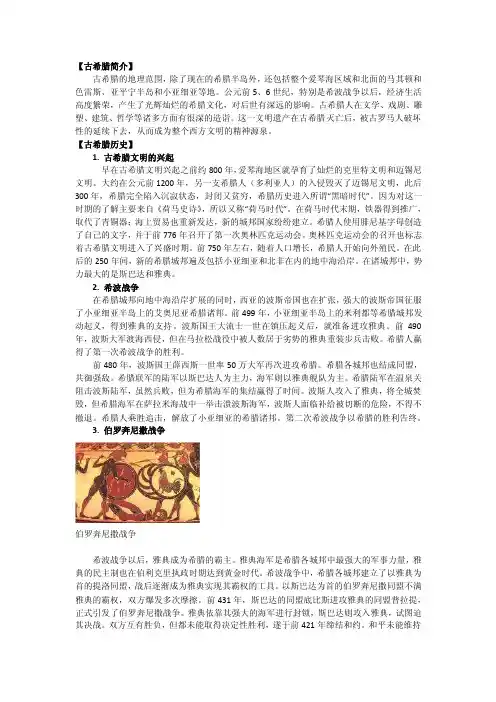
【古希腊简介】古希腊的地理范围,除了现在的希腊半岛外,还包括整个爱琴海区域和北面的马其顿和色雷斯、亚平宁半岛和小亚细亚等地。
公元前5、6世纪,特别是希波战争以后,经济生活高度繁荣,产生了光辉灿烂的希腊文化,对后世有深远的影响。
古希腊人在文学、戏剧、雕塑、建筑、哲学等诸多方面有很深的造诣。
这一文明遗产在古希腊灭亡后,被古罗马人破坏性的延续下去,从而成为整个西方文明的精神源泉。
【古希腊历史】1. 古希腊文明的兴起早在古希腊文明兴起之前约800年,爱琴海地区就孕育了灿烂的克里特文明和迈锡尼文明。
大约在公元前1200年,另一支希腊人(多利亚人)的入侵毁灭了迈锡尼文明,此后300年,希腊完全陷入沉寂状态,封闭又贫穷,希腊历史进入所谓“黑暗时代”。
因为对这一时期的了解主要来自《荷马史诗》,所以又称“荷马时代”。
在荷马时代末期,铁器得到推广,取代了青铜器;海上贸易也重新发达,新的城邦国家纷纷建立。
希腊人使用腓尼基字母创造了自己的文字,并于前776年召开了第一次奥林匹克运动会。
奥林匹克运动会的召开也标志着古希腊文明进入了兴盛时期。
前750年左右,随着人口增长,希腊人开始向外殖民。
在此后的250年间,新的希腊城邦遍及包括小亚细亚和北非在内的地中海沿岸。
在诸城邦中,势力最大的是斯巴达和雅典。
2. 希波战争在希腊城邦向地中海沿岸扩展的同时,西亚的波斯帝国也在扩张,强大的波斯帝国征服了小亚细亚半岛上的艾奥尼亚希腊诸邦。
前499年,小亚细亚半岛上的米利都等希腊城邦发动起义,得到雅典的支持。
波斯国王大流士一世在镇压起义后,就准备进攻雅典。
前490年,波斯大军渡海西侵,但在马拉松战役中被人数居于劣势的雅典重装步兵击败。
希腊人赢得了第一次希波战争的胜利。
前480年,波斯国王薛西斯一世率50万大军再次进攻希腊。
希腊各城邦也结成同盟,共御强敌。
希腊联军的陆军以斯巴达人为主力,海军则以雅典舰队为主。
希腊陆军在温泉关阻击波斯陆军,虽然兵败,但为希腊海军的集结赢得了时间。
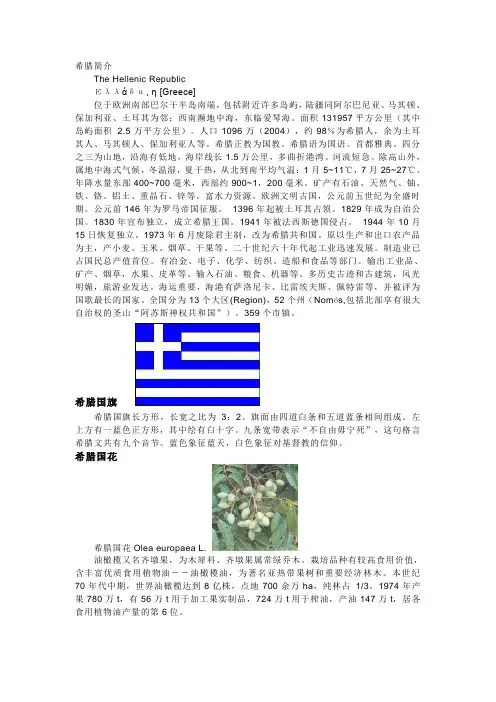
The Hellenic RepublicΕλλάδα, η [Greece]位于欧洲南部巴尔干半岛南端,包括附近许多岛屿,陆疆同阿尔巴尼亚、马其顿、保加利亚、土耳其为邻;西南濒地中海,东临爱琴海。
面积131957平方公里(其中岛屿面积 2.5万平方公里)。
人口1096万(2004),约98%为希腊人,余为土耳其人、马其顿人、保加利亚人等。
希腊正教为国教。
希腊语为国语。
首都雅典。
四分之三为山地,沿海有低地,海岸线长1.5万公里,多曲折港湾。
河流短急。
除高山外,属地中海式气候,冬温湿,夏干热,从北到南平均气温:1月5~11℃,7月25~27℃。
年降水量东部400~700毫米,西部约900~1,200毫米。
矿产有石油、天然气、铀、铁、铬、铝土、重晶石、锌等。
富水力资源。
欧洲文明古国,公元前五世纪为全盛时期。
公元前146年为罗马帝国征服。
1396年起被土耳其占领。
1829年成为自治公国。
1830年宣布独立,成立希腊王国。
1941年被法西斯德国侵占。
1944年10月15日恢复独立。
1973年6月废除君主制,改为希腊共和国。
原以生产和出口农产品为主,产小麦、玉米、烟草、干果等。
二十世纪六十年代起工业迅速发展。
制造业已占国民总产值首位。
有冶金、电子、化学、纺织、造船和食品等部门。
输出工业品、矿产、烟草,水果、皮革等。
输入石油、粮食、机器等。
多历史古迹和古建筑,风光明媚,旅游业发达。
海运重要,海港有萨洛尼卡、比雷埃夫斯、佩特雷等,并被评为国歌最长的国家。
全国分为13个大区(Region),52个州(Nomós,包括北部享有很大自治权的圣山“阿苏斯神权共和国”)。
359个市镇。
希腊国旗希腊国旗长方形,长宽之比为3:2。
旗面由四道白条和五道蓝条相间组成。
左上方有一蓝色正方形,其中绘有白十字。
九条宽带表示“不自由毋宁死”,这句格言希腊文共有九个音节。
蓝色象征蓝天,白色象征对基督教的信仰。
希腊国花希腊国花Olea europaea L.油橄榄又名齐墩果,为木犀科、齐墩果属常绿乔木。

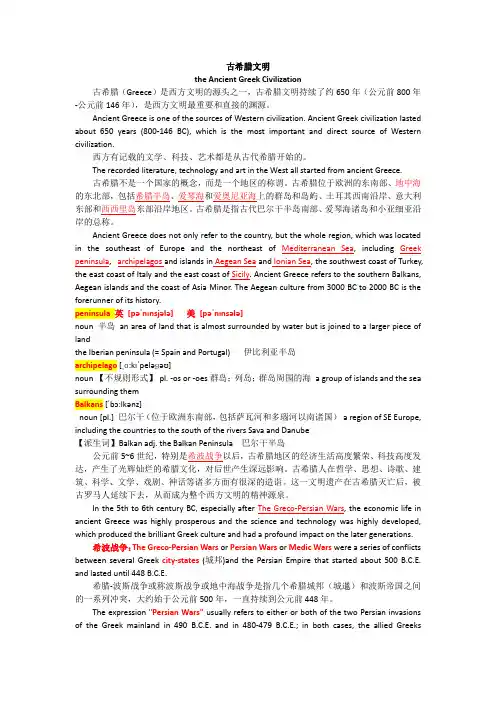
古希腊文明the Ancient Greek Civilization古希腊(Greece)是西方文明的源头之一,古希腊文明持续了约650年(公元前800年-公元前146年),是西方文明最重要和直接的渊源。
Ancient Greece is one of the sources of Western civilization. Ancient Greek civilization lasted about 650 years (800-146 BC), which is the most important and direct source of Western civilization.西方有记载的文学、科技、艺术都是从古代希腊开始的。
The recorded literature, technology and art in the West all started from ancient Greece.古希腊不是一个国家的概念,而是一个地区的称谓。
古希腊位于欧洲的东南部、地中海的东北部,包括希腊半岛、爱琴海和爱奥尼亚海上的群岛和岛屿、土耳其西南沿岸、意大利东部和西西里岛东部沿岸地区。
古希腊是指古代巴尔干半岛南部、爱琴海诸岛和小亚细亚沿岸的总称。
Ancient Greece does not only refer to the country, but the whole region, which was located in the southeast of Europe and the northeast of Mediterranean Sea, including Greek peninsula, and islands in Aegean Sea and Ionian Sea, the southwest coast of Turkey, the east coast of Italy and the east coast of Sicily. Ancient Greece refers to the southern Balkans, Aegean islands and the coast of Asia Minor. The Aegean culture from 3000 BC to 2000 BC is the forerunner of its history.peninsula 英[pəˈnɪnsjələ] 美[pəˈnɪnsələ]noun 半岛an area of land that is almost surrounded by water but is joined to a larger piece of landthe Iberian peninsula (= Spain and Portugal) 伊比利亚半岛archipelago[ˌɑːkɪˈpeləɡəʊ]noun 【不规则形式】pl. -os or -oes群岛;列岛;群岛周围的海a group of islands and the sea surrounding themBalkans [ˈbɔːlkənz]noun [pl.] 巴尔干(位于欧洲东南部,包括萨瓦河和多瑙河以南诸国)a region of SE Europe, including the countries to the south of the rivers Sava and Danube【派生词】Balkan adj. the Balkan Peninsula 巴尔干半岛公元前5~6世纪,特别是希波战争以后,古希腊地区的经济生活高度繁荣、科技高度发达,产生了光辉灿烂的希腊文化,对后世产生深远影响。
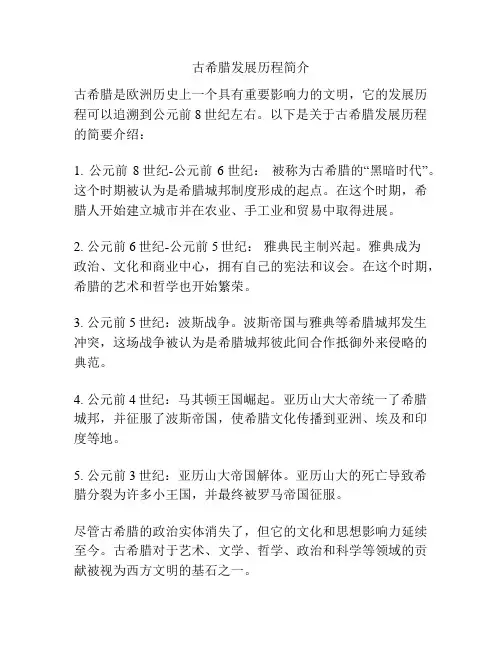
古希腊发展历程简介
古希腊是欧洲历史上一个具有重要影响力的文明,它的发展历程可以追溯到公元前8世纪左右。
以下是关于古希腊发展历程的简要介绍:
1. 公元前8世纪-公元前6世纪:被称为古希腊的“黑暗时代”。
这个时期被认为是希腊城邦制度形成的起点。
在这个时期,希腊人开始建立城市并在农业、手工业和贸易中取得进展。
2. 公元前6世纪-公元前5世纪:雅典民主制兴起。
雅典成为
政治、文化和商业中心,拥有自己的宪法和议会。
在这个时期,希腊的艺术和哲学也开始繁荣。
3. 公元前5世纪:波斯战争。
波斯帝国与雅典等希腊城邦发生冲突,这场战争被认为是希腊城邦彼此间合作抵御外来侵略的典范。
4. 公元前4世纪:马其顿王国崛起。
亚历山大大帝统一了希腊城邦,并征服了波斯帝国,使希腊文化传播到亚洲、埃及和印度等地。
5. 公元前3世纪:亚历山大帝国解体。
亚历山大的死亡导致希腊分裂为许多小王国,并最终被罗马帝国征服。
尽管古希腊的政治实体消失了,但它的文化和思想影响力延续至今。
古希腊对于艺术、文学、哲学、政治和科学等领域的贡献被视为西方文明的基石之一。

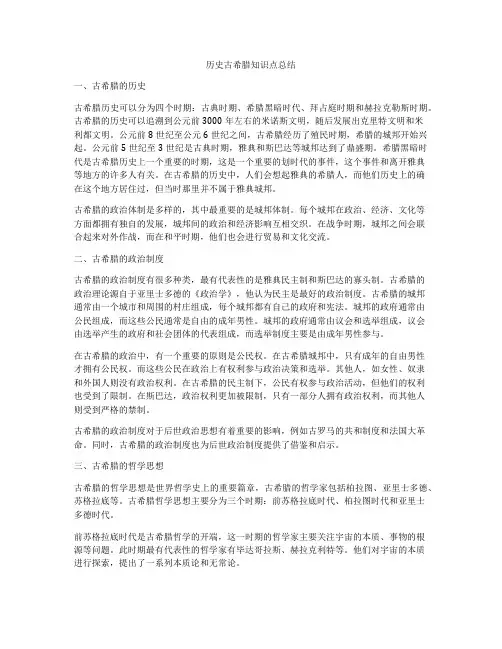
历史古希腊知识点总结一、古希腊的历史古希腊历史可以分为四个时期:古典时期、希腊黑暗时代、拜占庭时期和赫拉克勒斯时期。
古希腊的历史可以追溯到公元前3000年左右的米诺斯文明,随后发展出克里特文明和米利都文明。
公元前8世纪至公元6世纪之间,古希腊经历了殖民时期,希腊的城邦开始兴起。
公元前5世纪至3世纪是古典时期,雅典和斯巴达等城邦达到了鼎盛期。
希腊黑暗时代是古希腊历史上一个重要的时期,这是一个重要的划时代的事件,这个事件和离开雅典等地方的许多人有关。
在古希腊的历史中,人们会想起雅典的希腊人,而他们历史上的确在这个地方居住过,但当时那里并不属于雅典城邦。
古希腊的政治体制是多样的,其中最重要的是城邦体制。
每个城邦在政治、经济、文化等方面都拥有独自的发展,城邦间的政治和经济影响互相交织。
在战争时期,城邦之间会联合起来对外作战,而在和平时期,他们也会进行贸易和文化交流。
二、古希腊的政治制度古希腊的政治制度有很多种类,最有代表性的是雅典民主制和斯巴达的寡头制。
古希腊的政治理论源自于亚里士多德的《政治学》,他认为民主是最好的政治制度。
古希腊的城邦通常由一个城市和周围的村庄组成,每个城邦都有自己的政府和宪法。
城邦的政府通常由公民组成,而这些公民通常是自由的成年男性。
城邦的政府通常由议会和选举组成,议会由选举产生的政府和社会团体的代表组成,而选举制度主要是由成年男性参与。
在古希腊的政治中,有一个重要的原则是公民权。
在古希腊城邦中,只有成年的自由男性才拥有公民权。
而这些公民在政治上有权利参与政治决策和选举。
其他人,如女性、奴隶和外国人则没有政治权利。
在古希腊的民主制下,公民有权参与政治活动,但他们的权利也受到了限制。
在斯巴达,政治权利更加被限制,只有一部分人拥有政治权利,而其他人则受到严格的禁制。
古希腊的政治制度对于后世政治思想有着重要的影响,例如古罗马的共和制度和法国大革命。
同时,古希腊的政治制度也为后世政治制度提供了借鉴和启示。
经典希腊神话故事(精选12篇)经典希腊神话故事12篇 ⼀、希腊的简介 希腊共和国(希腊语:Ελληνικ Δηµοκρατα,英语:The Hellenic Republic),简称希腊(希腊语:Ελλδα,英语:Greece),是地处欧洲东南⾓、巴尔⼲半岛的南端的共和制国家。
全国由半岛南部的伯罗奔尼撒半岛和爱琴海中的3000余座岛屿构成。
希腊为连接欧亚⾮的战略要地,本⼟从西北⾄正北部分别邻阿尔巴尼亚、北马其顿、保加利亚三国,东北与⼟⽿其国境接壤。
周围⾃东⽽西分别濒临爱琴海、地中海本域与伊奥尼亚海。
希腊被视为西⽅⽂明的发源地,历史可上溯到古希腊。
公元前3000年~公元前1100年克⾥特岛曾出现⽶诺斯⽂明,公元前1600年~公元前1050年伯罗奔尼撒半岛出现迈锡尼⽂明。
公元前800年形成奴⾪制国家,公元前5世纪发展⾄以雅典和斯巴达为代表的希腊城邦⿍盛时期。
公元前146年并⼊罗马帝国。
后为拜占庭帝国的核⼼部分,以希腊语及希腊⽂化所主导。
15世纪中期被奥斯曼帝国统治。
1821年,爆发希腊独⽴战争。
1832年建⽴希腊王国。
1974年通过全民公投改为共和制。
希腊是民主制度、西⽅哲学、奥林匹克运动会、西⽅⽂学、历史学、政治学、科学和数学原理,以及西⽅戏剧的发源地。
希腊⽂化与技术进步对世界历史具有极⼤的影响⼒,通过亚历⼭⼤⼤帝和拜占庭帝国传播⾄西⽅世界和东⽅世界。
希腊是⼀个发达的资本主义国家,也是欧盟、欧元区、申根区、北约的成员国。
希腊⽣活质量较⾼,⼈类发展指数为极⾼。
独特的⽂化、旅游业、船运业及战略地位使其跻⾝中等强国之列。
⼆、经典希腊神话故事(精选12篇) 神话故事是中国古代⼈们经过长期的社会实践,在劳动⽣活的过程中创造出来的⼀种⽂学样式。
以下是⼩编为⼤家收集的经典希腊神话故事(精选12篇),仅供参考,希望能够帮助到⼤家。
经典希腊神话故事1 特洛伊城的建⽴ 伊阿西翁是是宙斯与海洋⼥神普勒阿得斯所⽣的⼉⼦,但他⾃以为是神的⼉⼦,竟敢于窥视奥林匹斯圣⼭上的⼀位⼥⼦,并以狂热的感情追逐⼥神得墨忒⽿。
希腊英文介绍(3篇)以下是网友分享的关于希腊英文介绍的资料3篇,希望对您有所帮助,就爱阅读感谢您的支持。
希腊英文介绍篇一CulturePhilosophyMain article: Ancient Greek philosophyAncient Greek philosophy focused on the role of reason and inquiry. In many ways, it had an important influence on modern philosophy, as well as modern science. Clear unbroken lines of influence lead from ancient Greek and Hellenistic philosophers, to medieval Muslim philosophersand Islamic scientists, to the European Renaissance and Enlightenment, to the secular sciences of the modern day.Neither reason nor inquiry began with the Greeks. Defining the difference between the Greek quest for knowledge and the quests of the elder civilizations, such as the ancient Egyptians and Babylonians, has long been a topic of study by theorists of civilization.LiteratureMain articles: Ancient Greek literature, Greek tragedy, Greek comedy, and Theatre of ancient GreeceAncient Greek society placed considerable emphasis upon literature. Many authors consider the western literary tradition to have begun with the epic poems The Iliad and The Odyssey, which remain giants in the literary canon fortheir skillful and vivid depictions of war and peace, honor and disgrace, love and hatred. Notable among later Greek poets was Sappho, who defined, in many ways, lyric poetry as a genre.A playwright named Aeschylus changed Western literature forever when he introduced the ideas of dialogue and interacting characters to playwriting. In doing so, he essentially in vented ―drama‖: his Oresteia trilogy of plays is seen as his crowning achievement. Other refiners of playwriting were Sophocles and Euripides. Sophocles is credited with skillfully developing irony as a literary technique, most famously in his play Oedipus the King. Euripedes, conversely, used plays to challenge societal norms and mores—a hallmark of much of Western literature for the next 2,300 years and beyond—and his works such as Medea, The Bacchae and The Trojan Women are still notable for their ability to challenge our perceptions of propriety, gender, and war. Aristophanes, a comic playwright, defines and shapes the idea of comedy almost asAeschylus had shaped tragedy as an art form—Aristophanes’ most famous plays include the Lysistrata and The Frogs.Philosophy entered literature in the dialogues of Plato, who converted the give and take of Socratic questioning into written form. Aristotle, Plato’s student, wrote dozens of works on many scientific disciplines, but his greatest contribution to literature was likely his Poetics, which lays out his understanding of drama, and thereby establishes the first criteria for literary criticism.Science & T echnologyMain articles: List of Graeco-Roman geographers, Greek astronomy, Greek mathematics, Medicine in ancient Greece, and Ancient Greek technologyAncient Greece mathematics contributed many important developments to the field of mathematics, including the basic rules of geometry, the idea of formal mathematical proof, and discoveries in number theory, mathematical analysis, applied mathematics, and approached close to establishing the integral calculus. The discoveries of several Greek mathematicians, including Pythagoras, Euclid, and Archimedes, are still used in mathematical teaching today.The Greeks developed astronomy, which they treated as a branch of mathematics, to a highly sophisticated level. The first geometrical, three-dimensional models to explain the apparent motion of the planets were developed in the 4th century BC by Eudoxus of Cnidus and Callippus of Cyzicus. Their younger contemporary Heraclides Ponticus proposed that the Earth rotates around its axis. In the 3rd century BC Aristarchus of Samos was the first to suggest a heliocentric system, although only fragmentary descriptions of his idea survive.[18] Eratosthenes, using the angles of shadowscreated at widely-separated regions, estimated the circumference of the Earth with great accuracy.[19] In the 2nd century BC Hipparchus of Nicea made a number of contributions, including the first measurement of precession and the compilation of the first star catalog in which he proposed the modern system of apparent magnitudes.The Antikythera mechanism, a device for calculating the movements of planets, dates from about 80 B.C., and was the first ancestor of the astronomical computer. It was discovered in an ancient shipwreck off the Greek island of Antikythera, between Kythera and Crete. The device became famous for its use of a differential gear, previously believed to have been invented in the 16th century, and the miniaturization and complexity of its parts, comparable to a clock made in the 18th century. The original mechanism is displayed in the Bronze collection of the National Archaeological Museum of Athens, accompanied by a replica.The ancient Greeks also made important discoveries in the medical field. Hippocrates was a physician of the Classical period, and is considered one of the most outstanding figures in the history of medicine. He is ref erred to as the ―father of medicine‖[20][21][22] in recognition of his lasting contributions to the field as the founder of the Hippocratic school of medicine. This intellectual school revolutionized medicine in ancient Greece, establishing it as a discipline distinct from other fields that it had traditionally been associated with (notably theurgy and philosophy), thus making medicine a profession.[23][24]Art & ArchitectureMain articles: Art in ancient Greece and Architecture of ancient GreeceThe art of ancient Greece has exercised an enormousinfluence on the culture of many countries from ancient times until the present, particularly in the areas of sculpture and architecture. In the West, the art of the Roman Empire was largely derived from Greek models. In the East, Alexander the Great’s conquests initiated several centuries of exchange between Greek, Central Asian and Indian cultures, resulting in Greco-Buddhist art, with ramifications as far as Japan. Following the Renaissance in Europe, the humanist aesthetic and the high technical standards of Greek art inspired generations of European artists. Well into the 19th century, the classical tradition derived from Greece dominated the art of the western world.Religion & MythologyMain articles: Ancient Greek religion, Hellenistic religion, and Greek mythologyGreek mythology consists of stories belonging to theancient Greeks concerning their gods and heroes, the nature of the world and the origins and significance of their religious practices. The main Greek gods were the twelve Olympians, Zeus, his wife Hera, Poseidon, Ares, Hermes, Hephaestus, Aphrodite, Athena, Apollo, Artemis, Demeter, and Hades. Other important deities included Hebe, Helios, Dionysus, Persephone and Heracles (a demi-god). Zeus’ parents were Kronos and Rhea who also were the parents of Poseidon, Hades, Hera, Hestia, and Demeter.希腊英文介绍篇二Sappho .The Alexandrians included her in the list of nine lyric poets. Her birth was sometime between 630 and 612 BCE, and it is said that she died around 570 BCE, but little is known for certain about her life. The bulk of her poetry, which was well-known and greatly admired through much of antiquity, has been lost, but her immense reputation hasendured through surviving fragments. Sappho’s lifetime witnessed a period of political turbulence on Lesbos and saw the rise of Pittacus. According to the Parian Marble, Sappho was exiled to Sicily sometime between 604 BCE and 594 BCE and Cicero records that a statue of her stood in the town-hall of Syracuse. Unlike the works of her fellow poet, Alcaeus, Sappho’s surviving poetry has very few allusions to political conditions. The principal exception is Fragment 98, which mentions exile and indicates that Sappho was lacking some of her customary luxuries. Her political sympathies may have lain with the party of Alcaeus. Though there is no explicit record of this, it is usually assumed that Sappho returned from exile at some point and that she spent most of her life in Lesbos.David Campbell has briefly summarized some of the most arresting qualities of Sappho’s poetry Clarity of language and simplicity of thought are everywhere evident in our fragments; wit and rhetoric, so common in English love-poetry and not quite absent from Catullus’ love poems, arenowhere to be found. Her images are sharp —the sparrows that draw Aphrodite’s chariot, the full moon in a starry sky,the solitary red apple at the tree-top—and she sometimes lingers over them to elaborate them for their own sake. She quotes the direct words of conversations real or imaginary and so gains immediacy. When the subject is the turbulence of her emotions, she displays a cool control in their expression. Above all, her words are chosen for their sheer melody: the skill with which she placed her vowels and consonants, admired by Dionysius of Halicarnassus, is evidenced by almost any stanza; the music to which she sang them has gone, but the spoken sounds may still enchant. Out of over 200 remaining remnants of Sappho’s poetry, Fragment 16 and Fragment 44 in particular are considered lyric retellingsof Homer epics, as Sappho was known to be very familiar with Homer’s poems. Both fragments make direct allusions to scenes in Homer’s Iliad , while Sappho also expands them with her own narrative illustrations. Fragment 16, for instance, serves to characterise Helen, a key figure of Homer’s, while Fragment 44 glorifies domestic joy by depicting the events leading to the wedding of Hector and Andromache.The politi cal atmosphere of the Lesbos during Sappho’stime paralleled that of Homer’s Troy, as the cities of Lesbos were constantly plagued with threats from Lydia. Whereas Homer focused depicting beauty through the glory of militarism, however, Sappho focused primarily onthe portrayal of beauty through love. As oratory poets, both Homer and Sappho used their work to celebrate and memorialise events for posterity. The exigency of their verses was therefore to preserve information as well as to entertain.希腊英文介绍篇三DramaOrigin: perform plays at religious festivals.Develop: in the 5th century B.C. a powerful drama developedStates: open-air theatres, audience sat on stone benches and looked down at the stage from three sides, actors wore masksTragedyAeschylus (525 — 456 B.C.)Works: Prometheus Bound, Persians, and Agamemnon Inthese plays there are only two actors and a chorus. Yet they manage to stir and move the audience deeply by showing heroes and heroines in complicated human situations, out of which there is no escape but death. The play are written in verse. Aeschylus is noted for his vivid character portrayal and majestic poetry ComedyAristophanes (about 450 --- 380 B.C.) Works: Frogs, Clouds, Wasps and Birds These plays are loose in plot and satirical in tone.HistoryHerodotus希罗多德(484 --- 430 B.C.) ―Father of History, he wrote about the wars between Greeks and Persians. His history, full of anecdotes and digressions and lively dialogue, is wonderfully readable. He kept alive many traditional stories, which were not always accurate. His object in writing was ―that the great and wonderful deeds done by Greeks and Persians should not lack renown.Homer ( probably lived around 700 B.C.)Two epics: LliadOdysseusThey are about great men and wars of a remoter age,probably in the period 1200—1100B.CPhilosophy and ScienceThe ancient Greeks were curious about many things, including what made the universe. They had the spirit of free enquiry and were quite ready to drop established ideas, to speculate, to use their imagination and to form their own conclusions. They were also not afraid to speak their minds. Pythagoras 毕达哥拉斯(about 580 --- 500 B.C.) had the idea that all things were number. Heracleitue 赫拉克利特(about 540 --- 480 B.C.) believed fire to be the primary element of the universe He also said: You cannot step twice into the same river. The sun is new everyday Democritus 德谟克利特(about 460 --- 370 B.C.) speculated about the atomic structure of matter. He was one of the earliest exponents of the atomic theory.Socrates苏格拉底( about 470 --- 399 B.C.)The dialectical method --- method of argument, by questions and answers. Greek philosopher who initiated a question-and-answer method of teaching as a means ofachieving self-knowledge. His theories of virtue and justice have survived through the writings of Plato, his most important pupil. Socrates was tried for corrupting the minds of Athenian youth and subsequently put to death (399).Plato 柏拉图( about 428 ---348 B.C.)Men have knowledge because of the existence of certain general ―idea‖, like beauty, truth, goodness. Only these ―ideas‖ are completely real, while the physical world is only relatively real. For this reason, Plato‘s philosophy is called Idealism.(唯心主义) Greek philosopher. A follower of Socrates, he founded the Academy (386), where he taught and wrote for much of the rest of his life. Plato presented his ideas in the form of dramatic dialogues, as in The Republic. Aristotle 亚里士多德Greek philosopher. A pupil of Plato, the tutor of Alexander the Great, and the author of works on logic, metaphysics, ethics, natural sciences, politics, and poetics, he profoundly influenced Western thought. In his philosophical system theory follows empirical observation and logic, based on the syllogism三段论, is the essential method of rational inquiry.ScienceEuclid 欧几里得(约公元前3世纪的古希腊数学家) is even now well-known for his Element《几何原本》, a textbook of geometry, perhaps the most successful textbook ever written, because it was in use in English schools until the early years of the 20th century.Archimedes 阿基米德(287—212 B.C.) did important work not only in geometry, but also in arithmetic, machanics, and hydrostatics. ―Give me a place to stand, and I will move the world.‖ Greek science did not neglect ap plication. Mathematics, the purest of sciences, was applied in at least five fields: acoustics, optics, geography, statics and astronomy. Greek scientists collected a wealth of material and enquired into the proper method of doing scientific work. As a result, they were able to deduce theories and built up systems, which had a tremendous influence on later scientists.Greek MythologyGreek Mythology is a group of traditional tales told by the ancient Greeks about the deeds of gods, heroes and theirrelations with human beings.Its great influence upon the English language and literature is beyond description. A great number of words and idioms in the English language come from the Greek mythology.Godsthe old theogony : the Tians(旧神谱:奥林匹斯十二泰坦)the new theogony : the Gods (新神谱奥林匹斯十二主神)Heros——Perseus (珀尔修斯) Jason (伊阿宋) Heracles (赫拉克勒斯) Theseus (忒修斯) Monsters——Medusa(美杜莎) Minotaurus (米诺陶洛斯) Cerberus (刻耳柏洛斯)T oday we mainly want to talk about the Olympians.Zeus 宙斯Father of Gods and men the god of sky and thunderZeus is the ―Father of Gods and men‖ who rule the Olympians of Mount Olympus as a father rule the family. He is the god of sky and thunder in Greek mythology. However, he is known for his erotic escapades. These resulted in many godly and heroic offspring, including Athena, Apollo and so on.Apollo 阿波罗God of sun, healing and truth.One of Apollo’s most important daily tasks is to harness his chariot with four horses and drive the sun across the sky. During the day he drove his carriage of gold and ivory , and brought light , life and love to the great world below . Late in the afternoon he came to the end of his journey in the far western sea and got on his golden boat to return to his eastern homeAthena 雅典娜Goddess of wisdom, victory and war Athena is fierce and brave in battle but, only wars to defined the state and home from outside enemies. She is the goddess of the city, handicrafts, and agriculture. She invented the bridle, the trumpet, the flute, the pot, the plow, the yoke, the ship, and the chariot. She is the embodiment of wisdom, reason, and purity.Prometheus 普罗米修斯He was a champion of mankind, known for his wily intelligence, who stole fire from Zeus and gave it to mortals. Zeus then punished him for his crime by having him bound to a rock while a great eagle ate his liver every day only to have it grow back to be eaten again the next day. His myth has been treated by a number of ancient sources, in whichPrometheus is credited with –or blamed for –playing a pivotal role in the early history of mankind.。
希腊文化
一、希腊简介
国家基本情况
首都雅典Athens
面积 131,957.00 平方公里
同北京时差 -6.00
人口 1053.7万人(1998年)
语言希腊语 Greek
货币德拉克马(GKD)
民族希腊人占97.7%,土耳其人占1.3%,其它占1%。
宗教 98%的居民信奉东正教,穆斯林占1.3%,其它占0.7%。
希腊国花:油橄榄(olive growing),这种花象征希腊民族的骄傲,国家的繁荣。
二、雅典奥运会会徽介绍
橄榄枝(olive branch)的象征
奥运会会徽是宣传奥运会最具权威性的形象标志。
现代奥运会的会徽一般都饰有奥运会五环标志,再衬以反映东道国地理、历史、民俗特点的主体图案。
2004年奥运会回到奥林匹克运动发源地希腊雅典,1999年9月30日雅典奥组委公布了2004年雅典奥运会徽。
会徽的主体是一个橄榄枝缠绕而成的桂冠,形状为古雅典城形状。
在古代奥运会中,桂冠代表冠军的荣耀。
此外,橄榄树在雅典还被视为圣树。
橄榄枝象征和平,组成的图案同时也象征生命圈、天空和大海。
会徽下方是“雅典2004”字样和奥林匹克五环。
举行竞赛时,以橄榄枝作桂冠,奖励优胜者。
还把橄榄枝作为和平的标志。
三、习俗与禁忌
希腊人热情好客,非常注重个人之间的友谊,但由于历史、文化和宗教等多方面的原因,在与当地人交往时应注重以下问题:
1.希腊大多数人信奉希腊正教。
在希腊教堂里妇女应穿长裙,胳膊不可外露,而且妇女不得站到圣坛后面去。
2.希腊是个大男子主义传统较深的国家,为避免受到男人骚扰,女性单独外出时最好乘坐出租车,在外面就餐时最好选择一些较高档次的餐馆。
3.希腊人喜欢吸烟。
商务谈判和社交活动中都喜欢吸烟,甚至吃饭的时候也吸上几口香烟。
在公共场所人们也对张贴的禁止吸烟标志视而不见。
因此,在与当地人交往中不必对他们的吸烟习惯感到奇怪。
4.由于希腊外汇较为短缺,当地一些商店很欢迎顾客用美元或英磅等硬通货结帐付款。
在餐馆或酒吧通常应付给服务员相当于餐费15%的小费。
四、雅典卫城
雅典卫城(Acropolis, Athens),也称为雅典的阿克罗波利斯,希腊语为“阿克罗波利斯”,原意为“高处的城市”或“高丘上的城邦”,距今已有3000年的历史。
雅典卫城遗址位于今雅典城西南,建造在海拔150米(另有资料记为156米)的石灰岩山冈上,是祭祀雅典守护神雅典娜的神圣地,建筑群建设的总负责人是雕刻家菲迪亚斯。
卫城,原意是奴隶主统治者的圣地,古代在此建有神庙,同时又是城市防卫要塞。
公元前5世纪,雅典奴隶主民主政治时期,雅典卫城遂成为国家的宗教活动中心,自希腊联合各城邦战胜波斯入侵后,更被视为国家的象征。
每逢宗教节日或国家庆典,公民列队上山进行祭神活动。
在希腊古代遗址中,最为有名的当属均建造于雅典黄金时期的雅典卫城。
作为古希腊建筑的的代表作,雅典卫城达到了古希腊圣地建筑群、庙宇、柱式和雕刻的最高水平。
这些古建筑无可非议的堪称人类遗产和建筑精品,在建筑学史上具有重要地位。
迄今保存下来的大量的珍贵遗迹,集中展示了希腊的古代文明。
1987年根据文化遗产遴选标准被列入《世界遗产目录》,世界遗产委员会评价为:“文明、神话、宗教在希腊兴盛了一千多年。
阿克罗波利斯包含四个古希腊艺术最大的杰作——巴特农神庙、通廊、厄瑞克修姆庙和雅典娜胜利神庙——被认为是世界传统观念的象征。
”
五、游览名胜
帕特农神庙(Parthenon):是雅典卫城主体建筑,为歌颂雅典战胜波斯侵略者的胜利而建。
设计人为伊克梯诺(Ictinus)和卡里克利特(Callicrates)在希腊首都雅典卫城坐落的古城堡中心,石灰岩的山岗上,耸立着一座巍峨的长方形建筑物,神庙矗立在卫城的最高点,这就是在世界艺术宝库中著名的帕特农神庙。
帕特农神庙(又称雅典娜神庙):顾名思义,是供奉雅典的守护神雅典娜(Athena)的主神庙,“雅典”之名即源于此。
相传希腊古时候,智慧女神雅典娜与海神为争夺雅典的保护神地位,相持不下。
后来,主神宙斯决定:谁能给人类一件有用的东西,城就归谁。
海神波赛东赐给人类一匹象征战争的壮马,而智慧女神雅典娜献给人类一颗枝叶繁茂、果实累累、象征和平的油橄榄树。
人们渴望和平,不要战争,结果这座城归了女神雅典娜。
从此,她成了雅典的保护神,雅典因之得名。
后来人们就把雅典视为“酷爱和平之城”。
帕特农神庙位于雅典老城区卫城山中心最高点,建于公元前447,9年后(公元前438年)大庙封顶,又用6年,各项雕刻也告完成,由著名建筑师与雕刻师菲迪亚斯设计,被认为是多力克式建筑艺术的顶峰;有“希腊国宝”之称。
这座神庙历经两千多年的沧桑之变,如今庙顶已坍塌,雕像荡然无存,浮雕剥蚀严重,但从巍然屹立的柱廊中,还可以看出神庙当年的丰姿。
帕特农神庙是雅典卫城最重要的主体建筑。
帕特农神庙之名出于雅典娜的别号Parthenon,即希腊文∏αρθενωσ的转写,帕特农原意为贞女,是雅典娜的别名。
帕特农神庙也译为“帕台农神庙”或“巴特农神庙”。
帕特农神庙是供奉雅典娜女神的最大神殿,此庙不仅规模最宏伟,庙内还存放一尊黄金象牙镶嵌的全希腊最高大的雅典娜女神像(菲迪亚斯亲手制作)。